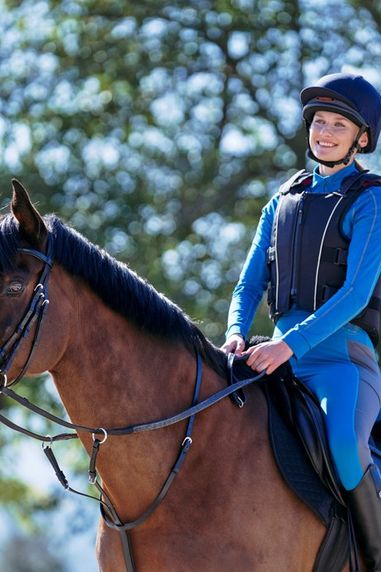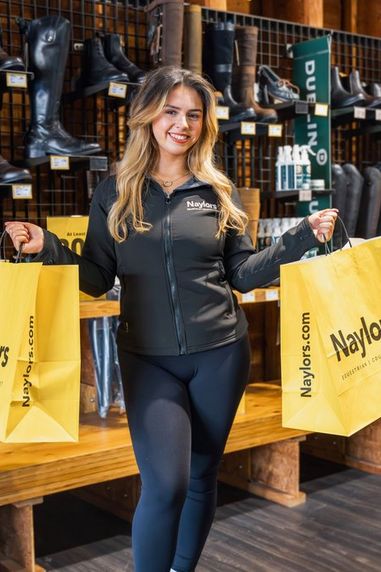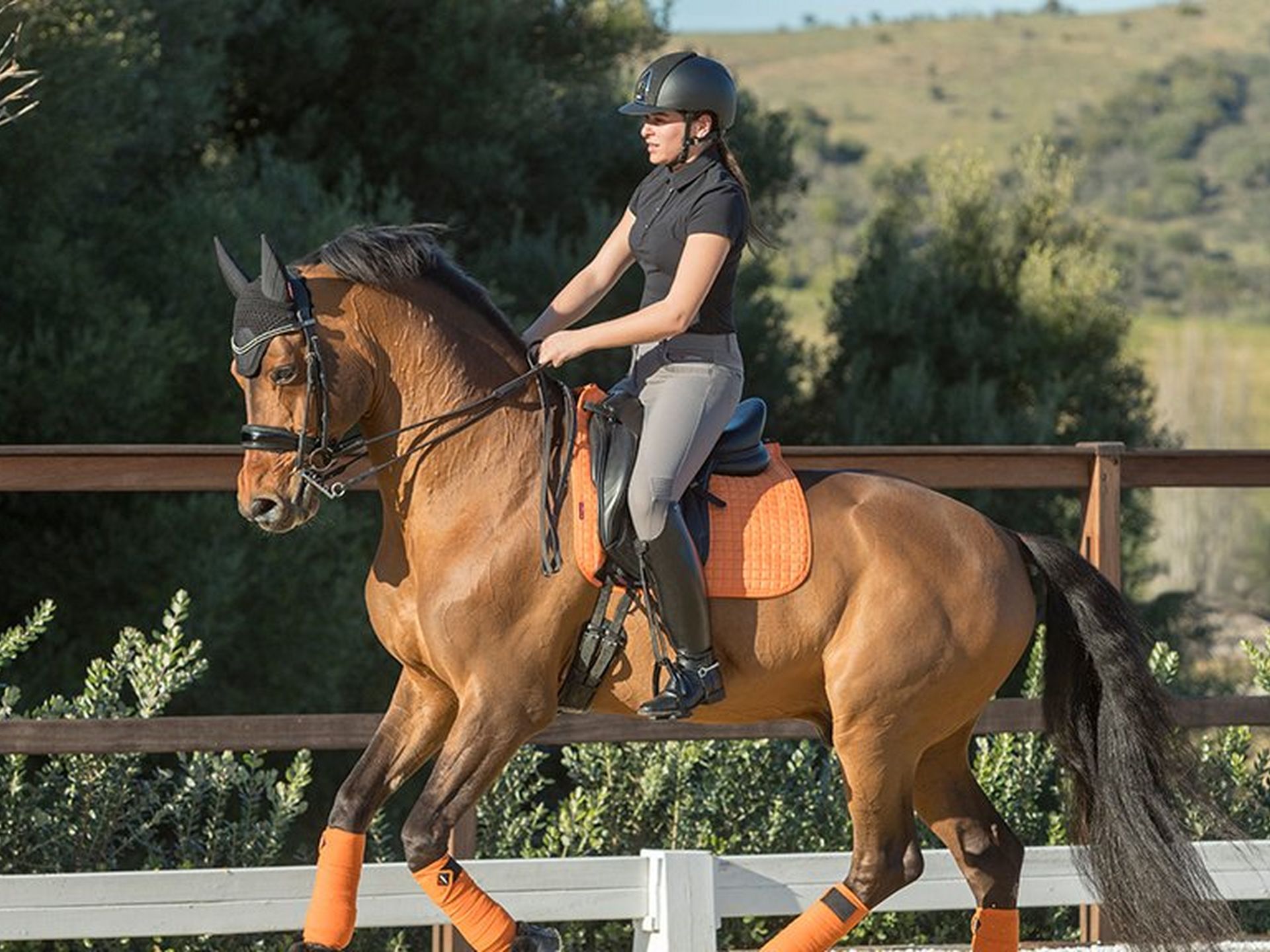
Schooling For Success
No matter what you aim to achieve with your horse, whether grand prix dressage, CCI3* eventing or a well mannered happy hacker, it all starts with schooling.
The German Scales Of Training
As with any form of training, schooling can feel like an endless task. It is fundamental to have a clear set of goals to help you direct your efforts. Though there are many ways to set training goals, The German Scales of Training are a great place to start. Used by judges and top international riders alike, you’ll soon wonder how you coped without them!
In essence The German Scales of Training build a stable pyramid of fundamental schooling skills. Firstly developing basic skills like rhythm and balance, then working up to more complex skills like straightness and collection. Get it right and you're all set to rival Valegro and Big Star!
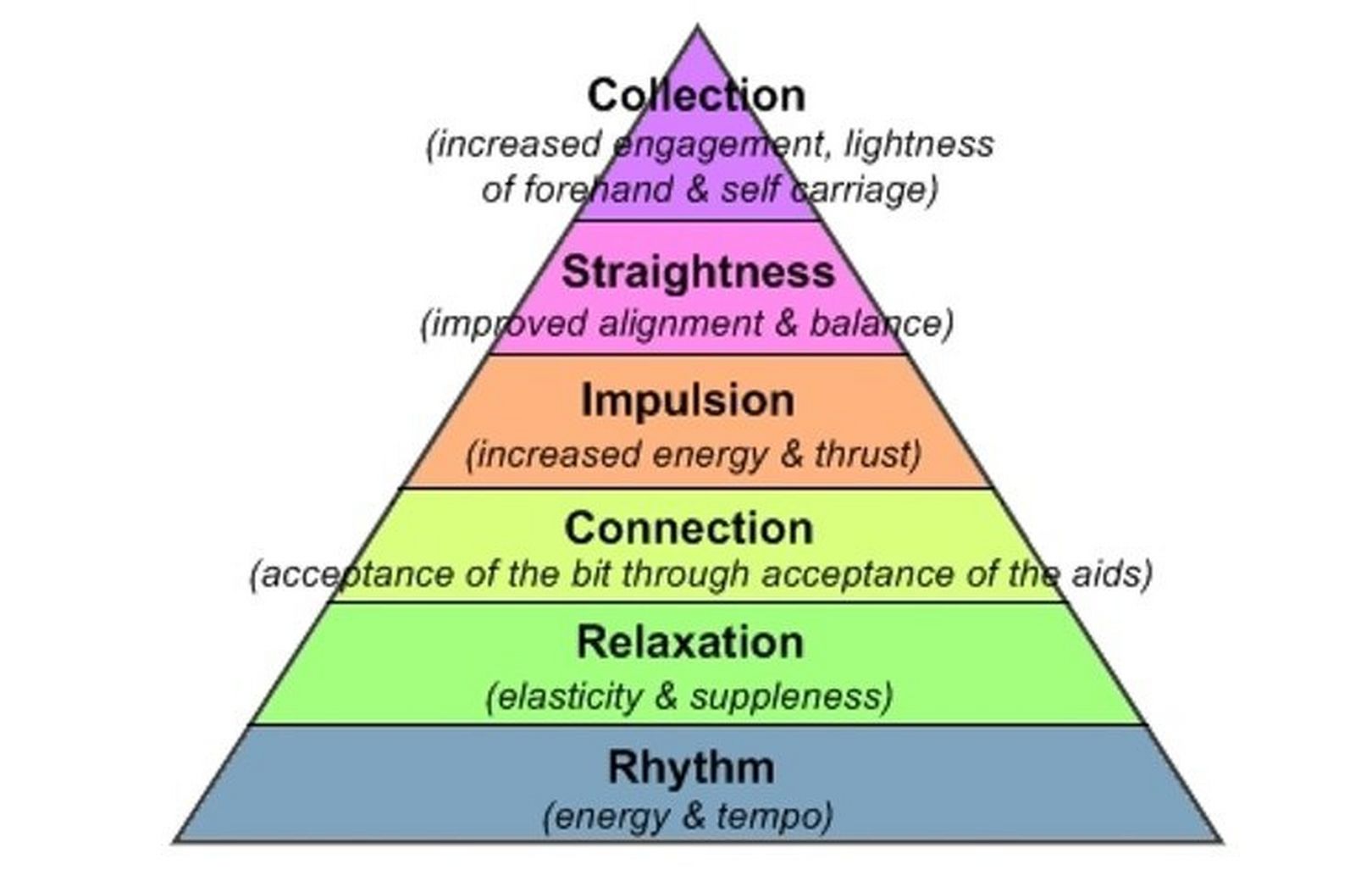
Source: Eventing Nation
1. Rhythm & Balance
It all starts with rhythm and balance! As you might expect for this your horse must first have correct gaits; four-beats in walk, two-beats in trot, three-beats in canter and four-beats in gallop... simple, right?
We wish. Achieving rhythm is a complex task. Rhythm refers to the regularity and tempo of your horse's gait, focusing not only on the speed he is travelling but the distance he is covering.
Training Exercises:
Groundwork: We know this is supposed to be about schooling but it’s hard to improve something if you don’t have a clear starting point. Lunging is a great way to find your horses natural rhythm without the interference of a rider.
A good way to start is to work through each gait and observe how your horse naturally moves. While doing this adjust his stride length and tempo, this will allow you to help him establish a way of going which is forward without rushing. Ask him to maintain this level, correcting him only when he makes a mistake. As mistakes become fewer you will be able to stop correcting him, without loss of rhythm or balance.
Once you have helped your horse find a comfortable rhythm in each gait you can start to introduce transitions. As we all know horses can often anticipate transitions leading to rushing or loosing impulsion. The key to perfecting transitions is spontaneity and repetition. Don’t be too predictable and don't lose patience. If he makes a mistake repeat the action and reward him when he gets it right. It's often better to have a horse that is in front of your leg, it shows judges that he is willing.
When you feel he is responsive to your aids and able to transition between the gaits smoothly you can work on developing his balance. This can be done by altering the size of your circle. Gently running your hand over the lunge line without closing it will subtly ask him to accept the bit and reduce the circle size. Making the circle gradually smaller will encourage him to bend through his body, engaging his hind quarters and allowing him to step under and track up correctly. You should then allow him to slowly take back the excess line until he is back to working on a large circle.
Remember, it is not advised to lunge your horse for in excess of 30 minutes at a time.
Riding: Now that you have established rhythm while lunging you can transfer it to under saddle. If your horse has truly become rhythmical and balanced on the lunge then this step is all about you! From a slight weight shift to unintentionally micromanaging, the more you unnecessarily alter your horses movement the harder it will be to achieve consistent rhythm.
Work through the previously mentioned steps, remembering to pay close attention to the hand, seat, voice and leg aids that you are giving. You should only be applying an aid if your horse has lost rhythm.
Top Tip - He might not be well known for schooling, but Geoff Billington summed this up perfectly: imagine that your horses energy is a rubber ball, if he rushes you lose the ball ahead of you, if he becomes lazy you will lose the ball behind of you. It's all about finding and maintaining a good rhythm!
2. Relaxation & Suppleness
A relaxed and supple horse is free from resistance to your aids. His muscles and joints should be loose, without tension. The most important muscles to focus on are those found over his top line; running from the hind legs, over the quarters and loins to the front of the wither and up to the poll.
Training Exercises:
Groundwork: Let's talk stretching!
Stretching is a great way for your horse to become more supple and to prevent muscle soreness between schooling sessions.
Riding: From basic circles to serpentines and zigzags, direction changes are a great way to help you horse become more supple when schooling.
Circles -
Get inventive! Circles don't have to be mindless or boring. They should be used to ask your horse to move around the arena without following the outside track. Try working from the top to the bottom of the arena using only 10m or 20m circles.
Direction Changes -
This doesn't just mean changing the rein across the centre of the school. Mix it up, follow the patterns below to encourage your horse to bend and use his body properly.
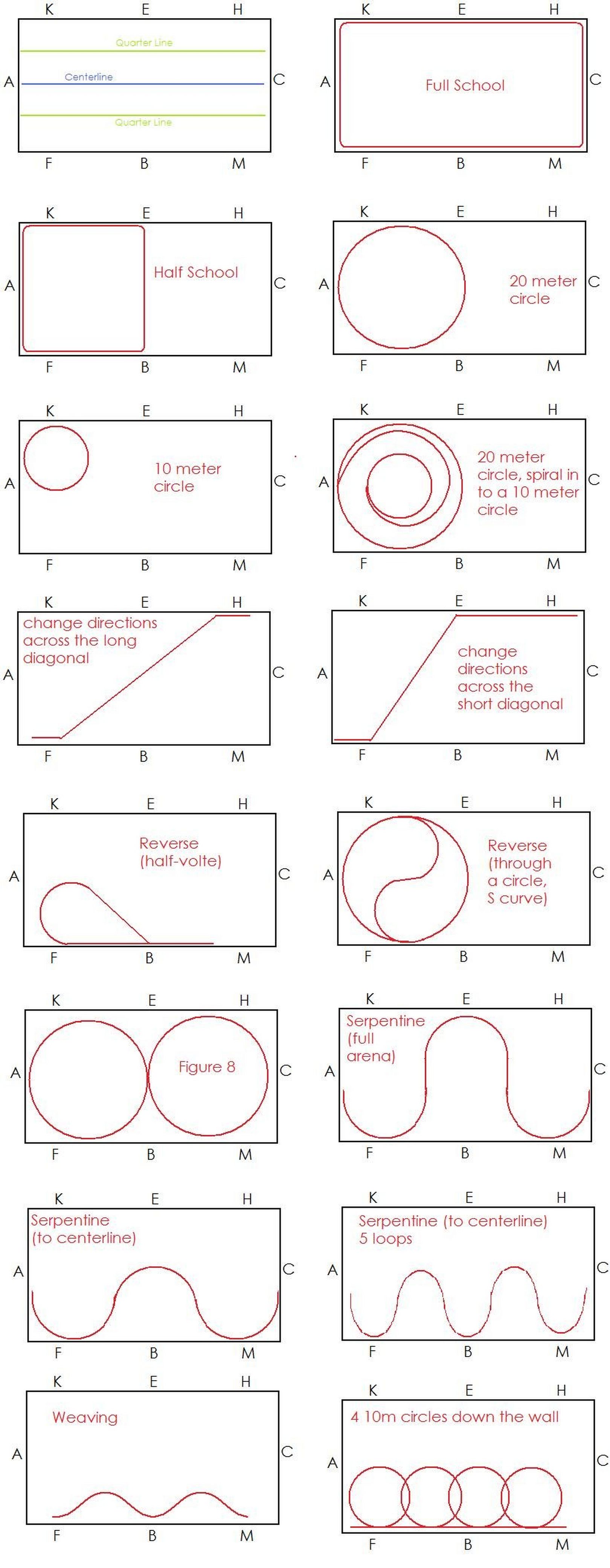
Source: Lessons In TR
You will know your horse has become more supple and relaxed when he will stretch forwards and down into a loose rein, without lifting his head or hollowing his back.
3. Contact/Connection
We've all seen young riders achieve 'a contact' by pulling their pony's head in. It's no surprise that this isn't right. When achieved in this way the horses back will hollow and his strides will shorten. A true contact is achieved by using aids from the leg and the seat not the hands.
You often hear the phrase 'riding from leg to hand'. In essence this means that you are using your leg as a driving aid, asking your horse to step under his body by pushing forwards from behind and working over the muscles along his top-line. When your horse is truly riding from leg to hand his outline should be relaxed and rounded as opposed to tense, short and hollow.
Training Exercises:
Groundwork: This is another example where lunging can be a really useful tool. We recommend using a lunging system, as they are designed to ask a horse to take their weight off the forehand and work from their hind quarters. This will help your horse to not only adopt the correct way of using his body, but help him to build muscle before he is expected to go correctly with a rider on his back. Horses that are not used to moving in this way will find it really difficult to begin with, so progression through the gaits should be gradual.
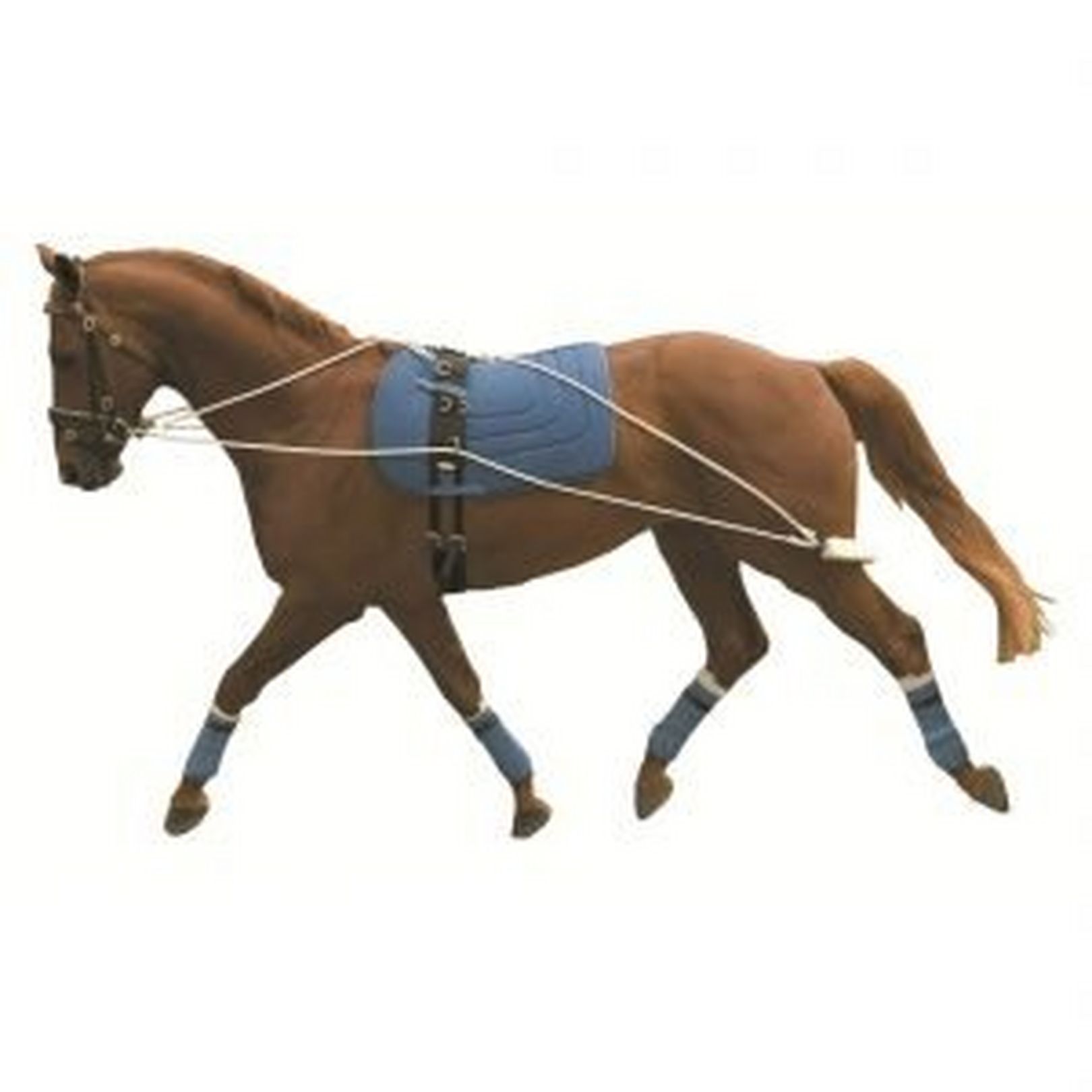
Riding: When your horse is truly 'on a contact' there will be a light, even and elastic feel down both reins. To achieve this think of your hands as collecting the energy you create with your leg and your seat. If your hands are too strong, you will overwrite the aids of you leg and confuse the horse. If your hands are too soft you will lose the energy and he will rush. Once you have found a balance, he should work from his hind quarters, over his top line and into the contact.
Using training aids such as a bungee or side reins can be helpful. These aren't their to force your horses head in but to help you to be more consistent. This is especially helpful if you usually school a heavy or hollow horse. As a general rule horses that lean on your hand will benefit from side reins, which won't give as easily to light pressure. A bungee will generally work better for horses with a lighter or more sensitive mouth. To find out more about training aids check out our full range below.
4. Impulsion
The phrase impulsion is a tricky to define. We've all been told that speed is not the same as impulsion, so what is it? Impulsion is the power of the horse created by the hind quarters and contained by the contact. So, impulsion is more like energy. As riders it is our task to create as much energy as can be contained without the horse losing the rhythm and balance we worked so hard to achieve. As i'm sure you already know this isn't easy.
Training Exercises:
Groundwork: Every day you lead your horse without much thought, why not make the most of this time? You might think of leading exercises as just a way to improve your horses manners, but it can be much more. By asking your horse to mirror your pace without having to use direct aids like your leg or hand you can make him more responsive to your voice and body language. This should help you to build his energy more effectively when schooling.
Lead your horse in-hand and work through a range of transitions and alterations within his gait. To truly build his energy this should be viewed more as an exciting game. To begin with it can be helpful to carry a schooling whip to correct him if he is lazy and fails to match your movements. If you have a more forward thinking horse it can be helpful to teach him to step back so you are able to correct him if he gets ahead of you. Getting this right can take a lot of practice so don't lose heart!
Riding: The first thing you need to remember when trying to improve your horse's impulsion is no nagging! Creating impulsion is about your horse understanding how you expect him to respond you your aids. If you start to nag your horse he will switch off to your leg. To improve his responsiveness you should think of your aids in a logical order working through the steps each time you apply them;
Forward Aids
- Seat
- Voice
- Leg
- Artificial Aid (whips or spurs)
Slowing Aids
- Seat
- Voice
- Pressure from Both Hands
Providing that he is rewarded by the removal of pressure once he has given the correct response, he will become lighter.
Once your horse is responsive, it's about using the aids in a way to ask him to give more energy without getting faster. This means that you need to learn how to ask him to contain his energy.
Containing Energy
1. Half-halts
Once you have generated energy it's all about containing it. This is where the previous steps come in! It's important that your horse doesn't mistake a half-halt as a sign to transition down, but as a way of containing his energy and asking him to shift his weight from the forehand to the hind quarters to rebalance him and create impulsion.
5. Straightness
When we say that a horse is moving straight, that doesn't necessarily mean he is walking in a straight line. It means that his hind hooves should fall directly in the track of his front hooves, whether he is going in a straight line or a circle.
Horses much like us are one sided. They will move forward with their bodies naturally curved. As riders it's our job to help them move straight, unfortunately we often sit to one side making the problem worse.
When you are trying to encourage your horse to work straight you need him to be using both sides of his body equally. In the offset you will need to ensure that his muscles are equally developed on both sides. His dominant side will often be stronger than his weaker side, so if you work them evenly from the start this won't change! You may therefore need to spend more time schooling to develop the muscles on his weaker side first.
Flatwork: Long reining is a great way to encourage your horse to work straight and track up correctly. Long reining will give you the chance to watch how your horse is moving and the ability to give him support against his sides, as you would with your leg to adjust his way of going.
Riding: When riding your horse you should aim to direct him with your seat and body. You should aim your shoulders and pelvis towards where you want him to go. This way you are not inadvertently asking him to turn or move unevenly. Straightness takes lots of practice and can only be achieved by ensuring that your horse is using both sides of his body equally.
6. Collection
Collection is what separates a good horse from a great horse and it can't be achieved without schooling! When a horse is first ridden he will carry the weight of the rider on his forehand. Collection is about asking him to transfer the weight to his hind quarters by stepping further under his body and pushing forward from behind.
Training Exercises:
Rein Back -
Remember, rein back is still a forwards movement. You still want the horse to be thinking forward and maintaining impulsion.
Turn On The Haunches -
A turn on the haunches is a great way to teach your horse to transfer his weight to his hind quarters. To complete a turn on the haunches the horse must shift his weight onto his hind to allow him to move his front legs around.
Remember, the German Scales of Training are a pyramid. You can't move on to the next level until have mastered the one before, otherwise it will all come toppling down!
We hope that this blog has given you some useful tips. Give them a try next time you school your horse. Don't forget to let us know how it goes! If you have any questions please leave us a comment and we will get back to you.



